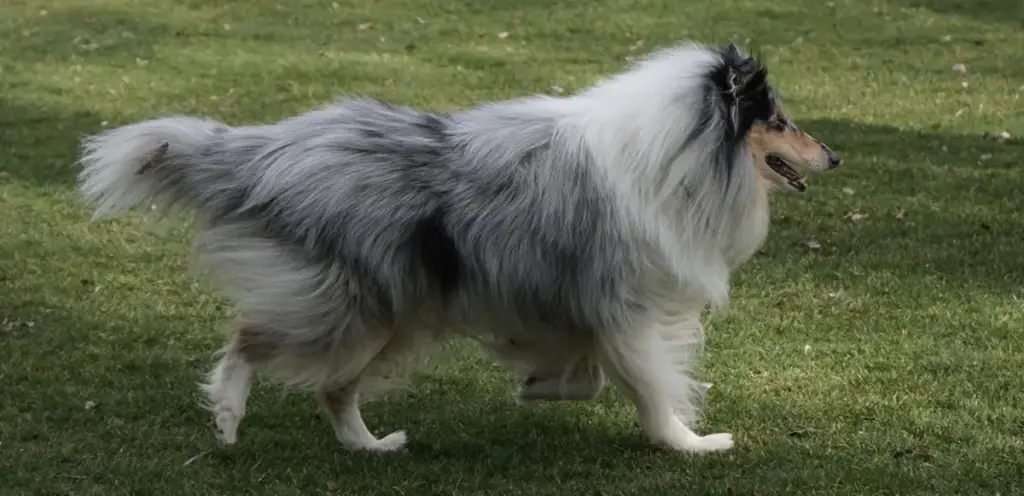When investigating Sheltie coat colors, you encounter a wide array of variations shaped by genetics. Sable Shelties range from golden to mahogany, while tricolor ones display a black coat with tan accents. Blue merle Shelties boast a unique marbled gray pattern, often with striking blue eyes. Genetics play a vital role, with the agouti gene determining sable and tricolor expressions, and the merle gene responsible for mottled patterns. However, double merles face health risks such as deafness. Understanding these genetic influences improves breed appreciation and guarantees responsible breeding and care. Delve further to deepen your comprehension of Sheltie genetics.
Sheltie Coat Color Variations
When exploring Shelties’ coat color variations, you’ll uncover a fascinating spectrum ranging from sable’s warm tones to tricolor’s striking contrasts. Each coat color tells a unique story about the color genes at play. The sable Sheltie exudes warmth with its golden to mahogany hues and black tipping. In contrast, tricolor Shelties display a vivid black base complemented by tan accents above the eyes and on the legs, creating a distinct look.
The blue merle Sheltie showcases a marbled pattern, where the merle gene dilutes black to a striking gray. This color variation often results in enchanting blue eyes. Bi-black Shelties, resembling a classic tuxedo, are primarily black and white, while bi-blue Shelties offer a sophisticated blue-gray and white combination without tan markings.
For those interested in unique appearances, color-headed white Shelties have white bodies with colored head markings. While intriguing, these may not always meet show standards. To understand these coat colors and variations better, you might want to contemplate genetic testing. Understanding these color variations helps you appreciate the diverse beauty of Shelties, and connects you to a community of enthusiasts.

Genetic Influences on Colors
To understand Sheltie colors, investigate their genetic foundations. The Agouti gene is crucial in determining whether a Sheltie sports a sable coat or a black one. With alleles for sable (a), tricolor (at), and bicolor (a), this gene influences the expression of coat color. Meanwhile, the semi-dominant Merle gene dilutes base colors, creating the iconic mottled patterns seen in blue merle Shelties. However, be cautious with Double Merles, since they can face health issues such as deafness due to excessive pigmentation dilution.
The Black gene (B) further shapes Sheltie colors by determining the presence of black pigment. Most Shelties are homozygous BB, ensuring a black nose and aligning with breed standards. Genetic variations, including the Ticking gene and Smut gene, also come into play, affecting white markings and color shading, respectively, and adding to the diversity of coat patterns.
Additionally, the Dilution gene (D) and Pigment Extension-Restriction gene (E) contribute to the wide array of color variants and genetic variations in Shelties. Together, these genes create the vibrant tapestry of Sheltie colors, each with its unique charm and character.
Sable to Bi-Color Shelties
Understanding the genetic foundations of Sheltie colors helps appreciate the variety seen from sable to bi-color coats. In the Sheltie breed, the sable shelties exhibit a range of colors from light golden to deep mahogany. Initially born gray, these dogs eventually mature into their vibrant adult coats. Mahogany sable shelties stand out with their darker, richer colors, often chestnut or mahogany, strikingly contrasting lighter sables.
On the other hand, Tri-color shelties possess a mainly black coat, accented by white markings and tan points. These tan points typically appear above the eyes and on the legs, following the classic Irish pattern. Bi-color shelties offer another dimension with their bold black fur and white Irish patterns, lacking any tan points entirely, resulting in the bi-black variant.
Sable merle shelties are a unique blend, combining the sable base with diluted pigment patches, often appearing blue or gray. The merle gene influences this variation, adding a fascinating interplay of colors. Each coat variation within the Sheltie breed showcases the rich tapestry of genetics, making every Sheltie unique and cherished in their way.
Health Considerations in Merles
The merle gene brings with it a fascinating array of colors in Shelties, but it also poses some critical health considerations. You’ll find that merle Shelties may display various eye colors, often including blue, which can be quite striking. However, the same gene responsible for these unique colors can lead to health issues, such as deafness and visual impairments. It’s important to note that Shelties, in general, are prone to hip dysplasia and eye disorders, so regular check-ups are vital. These problems are particularly prevalent in double merle Shelties, where lacking melanocytes can cause severe health challenges like microphthalmia and colobomas.
When considering breeding practices, you must be vigilant to avoid the production of double merles, since they’re prone to significant health problems. Genetic testing and regular health screenings are highly recommended for merle-colored Shelties to monitor potential issues linked to the merle gene. By understanding the health implications associated with the merle gene, you guarantee the well-being of the puppies and maintain the integrity of your breeding program.
Staying informed and proactive about your Shelties’ health not only supports their quality of life but also fosters a sense of belonging within the Sheltie community, where everyone is committed to their well-being.

Responsible Breeding Practices
When breeding Shelties, prioritizing responsible practices guarantees the health and well-being of future generations. As a dedicated breeder, you should focus on health testing to reduce the risk of genetic disorders, including eye disorders and hip dysplasia. It’s important to consider that Border Collies face similar health challenges, highlighting the need for vigilance in monitoring health issues. Selecting breeding pairs wisely, based on genetic testing, helps maintain the breed’s integrity and guarantees healthier puppies.
Ethical breeders understand the importance of socialization and temperament, ensuring puppies grow up well-adjusted and friendly. Your role is to provide a nurturing environment where puppies can develop positive interactions with people and other animals. This benefits the puppies and strengthens the bond within the Sheltie community, fostering a sense of belonging among owners and breeders alike.
Adhering to breed standards, including coat colors and patterns, is crucial. Avoid breeding double merles, as they can suffer from serious health issues such as hearing loss and vision problems. By sticking to accepted standards, you minimize the chances of producing non-standard puppies that might face disqualification in dog shows. Responsible breeding practices, grounded in thorough health and genetic testing, pave the way for a thriving, healthy Sheltie population.
Conclusion
In exploring Sheltie colors, you’ve navigated a spectrum important and varied as a painter’s palette. From the genetic underpinnings shaping sable and bi-color coats to the health nuances of merles, you’ve gained insight into the canine canvas. Understanding these elements is crucial for responsible breeding, ensuring healthy, vibrant Shelties. By grasping this knowledge, you contribute to the well-being of these beloved companions, fostering a legacy of beauty and vitality in every Sheltie generation.
